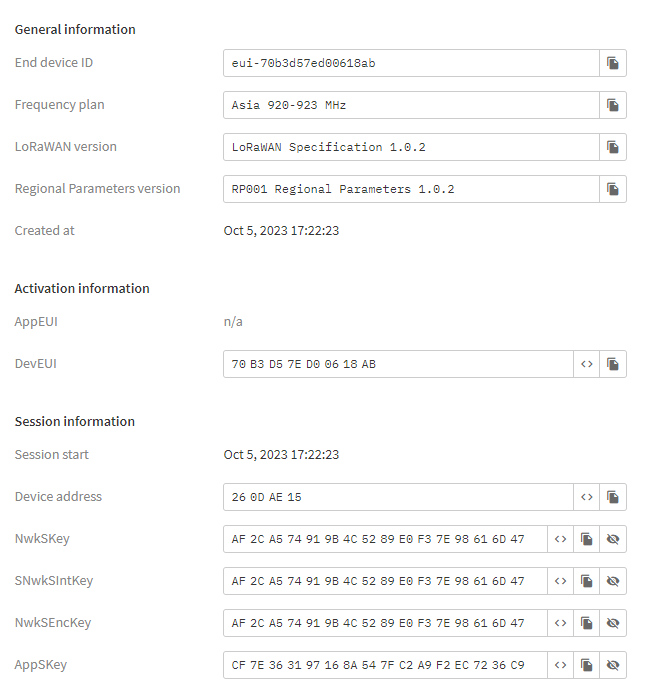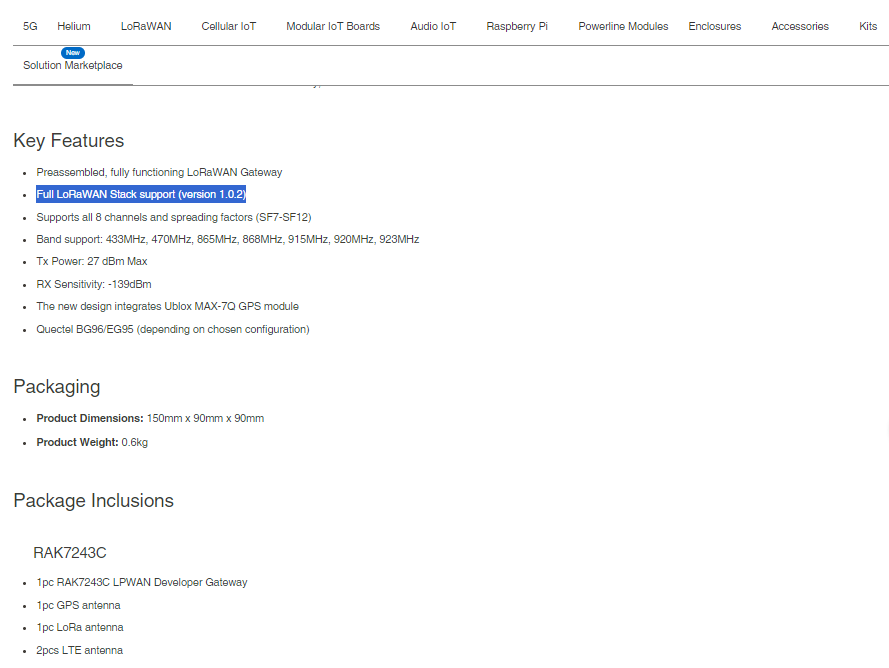Hi All I am using RAK7243C in AS-1 region which is successfully able to connect with The Things Network (TTN) cloud. However it’s not showing any live data coming from my Node. Can someone please help, below are the details:
I made an application with information as in the picture below in TTN:

Now, I am using whisper Node LoRa (Atmega328 + RFM95) to publish LoRa data. The library I am using is MCCI_LoRaWAN_LMIC_library-4.1.1. I had made an Arduino program as pasted below with its serial output mentioned after it:
Arduino Program:
/*******************************************************************************
* Copyright (c) 2015 Thomas Telkamp and Matthijs Kooijman
* Copyright (c) 2018 Terry Moore, MCCI
*
* Permission is hereby granted, free of charge, to anyone
* obtaining a copy of this document and accompanying files,
* to do whatever they want with them without any restriction,
* including, but not limited to, copying, modification and redistribution.
* NO WARRANTY OF ANY KIND IS PROVIDED.
*
* This example sends a valid LoRaWAN packet with payload "Hello,
* world!", using frequency and encryption settings matching those of
* the The Things Network.
*
* This uses ABP (Activation-by-personalisation), where a DevAddr and
* Session keys are preconfigured (unlike OTAA, where a DevEUI and
* application key is configured, while the DevAddr and session keys are
* assigned/generated in the over-the-air-activation procedure).
*
* Note: LoRaWAN per sub-band duty-cycle limitation is enforced (1% in
* g1, 0.1% in g2), but not the TTN fair usage policy (which is probably
* violated by this sketch when left running for longer)!
*
* To use this sketch, first register your application and device with
* the things network, to set or generate a DevAddr, NwkSKey and
* AppSKey. Each device should have their own unique values for these
* fields.
*
* Do not forget to define the radio type correctly in
* arduino-lmic/project_config/lmic_project_config.h or from your BOARDS.txt.
*
*******************************************************************************/
// References:
// [feather] adafruit-feather-m0-radio-with-lora-module.pdf
#include <lmic.h>
#include <hal/hal.h>
#include <SPI.h>
//
// For normal use, we require that you edit the sketch to replace FILLMEIN
// with values assigned by the TTN console. However, for regression tests,
// we want to be able to compile these scripts. The regression tests define
// COMPILE_REGRESSION_TEST, and in that case we define FILLMEIN to a non-
// working but innocuous value.
//
#ifdef COMPILE_REGRESSION_TEST
# define FILLMEIN 0
#else
# warning "You must replace the values marked FILLMEIN with real values from the TTN control panel!"
# define FILLMEIN (#dont edit this, edit the lines that use FILLMEIN)
#endif
// LoRaWAN NwkSKey, network session key
// This should be in big-endian (aka msb).
static const PROGMEM u1_t NWKSKEY[16] = {0xAF,0x2C,0xA5,0x74,0x91,0x9B,0x4C,0x52,0x89,0xE0,0xF3,0x7E,0x98,0x61,0x6D,0x47};
// LoRaWAN AppSKey, application session key
// This should also be in big-endian (aka msb).
static const u1_t PROGMEM APPSKEY[16] = {0xCF,0x7E,0x36,0x31,0x97,0x16,0x8A,0x54,0x7F,0xC2,0xA9,0xF2,0xEC,0x72,0x36,0xC9};
// LoRaWAN end-device address (DevAddr)
// See http://thethingsnetwork.org/wiki/AddressSpace
// The library converts the address to network byte order as needed, so this should be in big-endian (aka msb) too.
static const u4_t DEVADDR = 0x260DAE15 ; // <-- Change this address for every node!
// These callbacks are only used in over-the-air activation, so they are
// left empty here (we cannot leave them out completely unless
// DISABLE_JOIN is set in arduino-lmic/project_config/lmic_project_config.h,
// otherwise the linker will complain).
void os_getArtEui (u1_t* buf) { }
void os_getDevEui (u1_t* buf) { }
void os_getDevKey (u1_t* buf) { }
static uint8_t mydata[] = "a";
static osjob_t sendjob;
// Schedule TX every this many seconds (might become longer due to duty
// cycle limitations).
const unsigned TX_INTERVAL = 5000;
// Pin mapping
// Adapted for Feather M0 per p.10 of [feather]
const lmic_pinmap lmic_pins = {
.nss = 10, // chip select on feather (rf95module) CS
.rxtx = LMIC_UNUSED_PIN,
.rst = 7, // reset pin
.dio = {2, A2, A3}, // assumes external jumpers [feather_lora_jumper]
// DIO1 is on JP1-1: is io1 - we connect to GPO6
// DIO1 is on JP5-3: is D2 - we connect to GPO5
};
void onEvent (ev_t ev) {
Serial.print(os_getTime());
Serial.print(": ");
switch(ev) {
case EV_SCAN_TIMEOUT:
Serial.println(F("EV_SCAN_TIMEOUT"));
break;
case EV_BEACON_FOUND:
Serial.println(F("EV_BEACON_FOUND"));
break;
case EV_BEACON_MISSED:
Serial.println(F("EV_BEACON_MISSED"));
break;
case EV_BEACON_TRACKED:
Serial.println(F("EV_BEACON_TRACKED"));
break;
case EV_JOINING:
Serial.println(F("EV_JOINING"));
break;
case EV_JOINED:
Serial.println(F("EV_JOINED"));
break;
/*
|| This event is defined but not used in the code. No
|| point in wasting codespace on it.
||
|| case EV_RFU1:
|| Serial.println(F("EV_RFU1"));
|| break;
*/
case EV_JOIN_FAILED:
Serial.println(F("EV_JOIN_FAILED"));
break;
case EV_REJOIN_FAILED:
Serial.println(F("EV_REJOIN_FAILED"));
break;
case EV_TXCOMPLETE:
Serial.println(F("EV_TXCOMPLETE (includes waiting for RX windows)"));
if (LMIC.txrxFlags & TXRX_ACK)
Serial.println(F("Received ack"));
if (LMIC.dataLen) {
Serial.println(F("Received "));
Serial.println(LMIC.dataLen);
Serial.println(F(" bytes of payload"));
}
// Schedule next transmission
os_setTimedCallback(&sendjob, os_getTime()+sec2osticks(TX_INTERVAL), do_send);
break;
case EV_LOST_TSYNC:
Serial.println(F("EV_LOST_TSYNC"));
break;
case EV_RESET:
Serial.println(F("EV_RESET"));
break;
case EV_RXCOMPLETE:
// data received in ping slot
Serial.println(F("EV_RXCOMPLETE"));
break;
case EV_LINK_DEAD:
Serial.println(F("EV_LINK_DEAD"));
break;
case EV_LINK_ALIVE:
Serial.println(F("EV_LINK_ALIVE"));
break;
/*
|| This event is defined but not used in the code. No
|| point in wasting codespace on it.
||
|| case EV_SCAN_FOUND:
|| Serial.println(F("EV_SCAN_FOUND"));
|| break;
*/
case EV_TXSTART:
Serial.println(F("EV_TXSTART"));
break;
case EV_TXCANCELED:
Serial.println(F("EV_TXCANCELED"));
break;
case EV_RXSTART:
/* do not print anything -- it wrecks timing */
break;
case EV_JOIN_TXCOMPLETE:
Serial.println(F("EV_JOIN_TXCOMPLETE: no JoinAccept"));
break;
default:
Serial.print(F("Unknown event: "));
Serial.println((unsigned) ev);
break;
}
}
void do_send(osjob_t* j){
// Check if there is not a current TX/RX job running
if (LMIC.opmode & OP_TXRXPEND) {
Serial.println(F("OP_TXRXPEND, not sending"));
} else {
// Prepare upstream data transmission at the next possible time.
LMIC_setTxData2(1, mydata, sizeof(mydata)-1, 0);
Serial.println(F("Packet queued"));
}
// Next TX is scheduled after TX_COMPLETE event.
}
void setup() {
// pinMode(13, OUTPUT);
while (!Serial); // wait for Serial to be initialized
Serial.begin(115200);
delay(100); // per sample code on RF_95 test
Serial.println(F("Starting"));
#ifdef VCC_ENABLE
// For Pinoccio Scout boards
pinMode(VCC_ENABLE, OUTPUT);
digitalWrite(VCC_ENABLE, HIGH);
delay(1000);
#endif
// LMIC init
os_init();
// Reset the MAC state. Session and pending data transfers will be discarded.
LMIC_reset();
// Set static session parameters. Instead of dynamically establishing a session
// by joining the network, precomputed session parameters are be provided.
#ifdef PROGMEM
// On AVR, these values are stored in flash and only copied to RAM
// once. Copy them to a temporary buffer here, LMIC_setSession will
// copy them into a buffer of its own again.
uint8_t appskey[sizeof(APPSKEY)];
uint8_t nwkskey[sizeof(NWKSKEY)];
memcpy_P(appskey, APPSKEY, sizeof(APPSKEY));
memcpy_P(nwkskey, NWKSKEY, sizeof(NWKSKEY));
LMIC_setSession (0x13, DEVADDR, nwkskey, appskey);
#else
// If not running an AVR with PROGMEM, just use the arrays directly
LMIC_setSession (0x13, DEVADDR, NWKSKEY, APPSKEY);
#endif
#if defined(CFG_eu868)
// Set up the channels used by the Things Network, which corresponds
// to the defaults of most gateways. Without this, only three base
// channels from the LoRaWAN specification are used, which certainly
// works, so it is good for debugging, but can overload those
// frequencies, so be sure to configure the full frequency range of
// your network here (unless your network autoconfigures them).
// Setting up channels should happen after LMIC_setSession, as that
// configures the minimal channel set. The LMIC doesn't let you change
// the three basic settings, but we show them here.
LMIC_setupChannel(0, 923200000, DR_RANGE_MAP(DR_SF12, DR_SF7), BAND_CENTI); // g-band
LMIC_setupChannel(1, 923400000, DR_RANGE_MAP(DR_SF12, DR_SF7B), BAND_CENTI); // g-band
LMIC_setupChannel(2, 922200000, DR_RANGE_MAP(DR_SF12, DR_SF7), BAND_CENTI); // g-band
LMIC_setupChannel(3, 922400000, DR_RANGE_MAP(DR_SF12, DR_SF7), BAND_CENTI); // g-band
LMIC_setupChannel(4, 922600000, DR_RANGE_MAP(DR_SF12, DR_SF7), BAND_CENTI); // g-band
LMIC_setupChannel(5, 922800000, DR_RANGE_MAP(DR_SF12, DR_SF7), BAND_CENTI); // g-band
LMIC_setupChannel(6, 923000000, DR_RANGE_MAP(DR_SF12, DR_SF7), BAND_CENTI); // g-band
LMIC_setupChannel(7, 922000000, DR_RANGE_MAP(DR_SF12, DR_SF7), BAND_CENTI); // g-band
LMIC_setupChannel(8, 922100000, DR_RANGE_MAP(DR_FSK, DR_FSK), BAND_MILLI); // g2-band
// TTN defines an additional channel at 869.525Mhz using SF9 for class B
// devices' ping slots. LMIC does not have an easy way to define set this
// frequency and support for class B is spotty and untested, so this
// frequency is not configured here.
#elif defined(CFG_us915) || defined(CFG_au915)
// NA-US and AU channels 0-71 are configured automatically
// but only one group of 8 should (a subband) should be active
// TTN recommends the second sub band, 1 in a zero based count.
// https://github.com/TheThingsNetwork/gateway-conf/blob/master/US-global_conf.json
LMIC_selectSubBand(1);
#elif defined(CFG_as923)
// Set up the channels used in your country. Only two are defined by default,
// and they cannot be changed. Use BAND_CENTI to indicate 1% duty cycle.
// LMIC_setupChannel(0, 923200000, DR_RANGE_MAP(DR_SF12, DR_SF7), BAND_CENTI);
// LMIC_setupChannel(1, 923400000, DR_RANGE_MAP(DR_SF12, DR_SF7), BAND_CENTI);
// ... extra definitions for channels 2..n here
#elif defined(CFG_kr920)
// Set up the channels used in your country. Three are defined by default,
// and they cannot be changed. Duty cycle doesn't matter, but is conventionally
// BAND_MILLI.
// LMIC_setupChannel(0, 922100000, DR_RANGE_MAP(DR_SF12, DR_SF7), BAND_MILLI);
// LMIC_setupChannel(1, 922300000, DR_RANGE_MAP(DR_SF12, DR_SF7), BAND_MILLI);
// LMIC_setupChannel(2, 922500000, DR_RANGE_MAP(DR_SF12, DR_SF7), BAND_MILLI);
// ... extra definitions for channels 3..n here.
#elif defined(CFG_in866)
// Set up the channels used in your country. Three are defined by default,
// and they cannot be changed. Duty cycle doesn't matter, but is conventionally
// BAND_MILLI.
// LMIC_setupChannel(0, 865062500, DR_RANGE_MAP(DR_SF12, DR_SF7), BAND_MILLI);
// LMIC_setupChannel(1, 865402500, DR_RANGE_MAP(DR_SF12, DR_SF7), BAND_MILLI);
// LMIC_setupChannel(2, 865985000, DR_RANGE_MAP(DR_SF12, DR_SF7), BAND_MILLI);
// ... extra definitions for channels 3..n here.
#else
# error Region not supported
#endif
// Disable link check validation
LMIC_setLinkCheckMode(0);
// TTN uses SF9 for its RX2 window.
LMIC.dn2Dr = DR_SF9;
// Set data rate and transmit power for uplink
LMIC_setDrTxpow(DR_SF7,14);
// Start job
do_send(&sendjob);
}
void loop() {
unsigned long now;
now = millis();
if ((now & 512) != 0) {
digitalWrite(13, HIGH);
}
else {
digitalWrite(13, LOW);
}
os_runloop_once();
}
Serial output:
Starting
8515: EV_TXSTART
Packet queued
139219: EV_TXCOMPLETE (includes waiting for RX windows)
452198: EV_TXSTART
Packet queued
582908: EV_TXCOMPLETE (includes waiting for RX windows)
895888: EV_TXSTART
Packet queued
1026597: EV_TXCOMPLETE (includes waiting for RX windows)
1339665: EV_TXSTART
Packet queued
1470378: EV_TXCOMPLETE (includes waiting for RX windows)
1783360: EV_TXSTART
Packet queued
1914073: EV_TXCOMPLETE (includes waiting for RX windows)
2227058: EV_TXSTART
Packet queued
2357773: EV_TXCOMPLETE (includes waiting for RX windows)
2670755: EV_TXSTART
Packet queued
2801468: EV_TXCOMPLETE (includes waiting for RX windows)
3114532: EV_TXSTART
Packet queued
3245245: EV_TXCOMPLETE (includes waiting for RX windows)
3558228: EV_TXSTART
In case someone know how to resolve the issue, then please advise.
Thank you.
PS: Since, RAK7243C supports * Full LoRaWAN Stack support (version 1.0.2), I have made few changes as recommended in MCCI_LoRaWAN_LMIC_library-4.1.1’ libraries readme.:
Selecting V1.0.2
In project_config/lmic_project_config.h, add:
#define LMIC_LORAWAN_SPEC_VERSION LMIC_LORAWAN_SPEC_VERSION_1_0_2
On your compiler command line, add:
-D LMIC_LORAWAN_SPEC_VERSION=LMIC_LORAWAN_SPEC_VERSION_1_0_2
